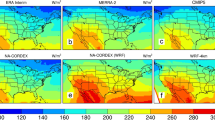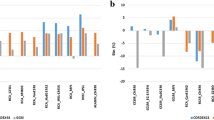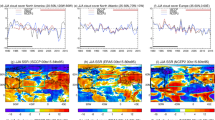Abstract
Observations indicate that solar radiation incident at the Earth surface underwent substantial decadal variations in the second half of the twentieth century, with a tendency towards reduction from the 1950s to the 1980s (“global dimming”) and a partial recovery thereafter (“brightening”) at widespread locations. The most reliable observational records from the Global Energy Balance Archive (GEBA) are used to evaluate the ability of the climate models participating in CMIP3/IPCC-AR4 as well as the ERA40 reanalysis to reproduce these decadal variations. The results from 23 models and reanalysis are analyzed in five different climatic regions where strong decadal variations in surface solar radiation (SSR) have been observed. Only about half of the models are capable of reproducing the observed decadal variations in a qualitative way, and all models show much smaller amplitudes in these variations than seen in the observations. Largely differing tendencies between the models are not only found under all-sky conditions, but also in cloud-free conditions and in the representation of cloud effects. The ERA40 reanalysis neither reproduces the major decadal variations in SSR, despite strong observational constraints on the temporal evolution of the state of the atmosphere, since time varying aerosol loadings are missing. Climate models and reanalyses are therefore not yet at a stage to provide regionally consistent estimates of decadal changes in SSR. Reproduction of these changes would be essential for an adequate representation of regional scale climate variations and impacts, and short-term (decadal) climate projections.










Similar content being viewed by others
References
Allan RP, Soden BJ (2007) Large discrepancy between observed and simulated precipitation trends in the ascending and descending branches of the tropical circulation. Geophys Res Lett 34(18):L18705. doi:10.1029/2007gl031460
Alpert P, Kishcha P, Kaufman YJ, Schwarzbard R (2005) Global dimming or local dimming? Effect of urbanization on sunlight availability. Geophys Res Lett 32(17):L17802. doi:10.1029/2005gl023320
Chiacchio M, Wild M (2010) Influence of nao and clouds on long-term seasonal variations of surface solar radiation in europe. J Geophys Res Atmospheres 115:D00d22. doi:10.1029/2009jd012182
Gilgen H, Ohmura A (1999) The global energy balance archive. Bull Am Meteorol Soc 80(5):831–850
Gilgen H, Wild M, Ohmura A (1998) Means and trends of shortwave irradiance at the surface estimated from global energy balance archive data. J Clim 11(8):2042–2061
Gilgen H, Roesch A, Wild M, Ohmura A (2009) Decadal changes in shortwave irradiance at the surface in the period from 1960 to 2000 estimated from global energy balance archive data. J Geophys Res Atmospheres 114:D00d08. doi:10.1029/2008jd011383
IPCC (2007) Climate change 2007: the physical science basis. Contribution of working group I to the fourth assessment report of the intergovernmental panel on climate change. Cambridge, United Kingdom and New York, NY, USA
Kennedy A, Dong X, Xi B, Minnis P, Del Genio A, Wolf A, Khaiver M (2010) Evaluation of the NASA GISS single column model simulated clouds using combined surface and satellite observations. J Climate 23:5175–5192. doi:10.1175/2010JCLI3353.1
Kumari BP, Londhe AL, Daniel S, Jadhav DB (2007) Observational evidence of solar dimming: offsetting surface warming over india. Geophys Res Lett 34(21):L21810. doi:10.1029/2007gl031133
Li HB, Robock A, Wild M (2007) Evaluation of intergovernmental panel on climate change fourth assessment soil moisture simulations for the second half of the twentieth century. J Geophys Res Atmospheres 112(D6):D06106. doi:10.1029/2006jd007455
Liepert BG (1990) Observed reductions of surface solar radiation at sites in the united states and worldwide from 1961 to 1990. Geophys Res Lett 29(10):1421. doi:10.1029/2002gl014910
Liu BH, Xu M, Henderson M, Qi Y, Li YQ (2004) Taking china’s temperature: daily range, warming trends, and regional variations, 1955–2000. J Clim 17(22):4453–4462
Makowski K, Jaeger EB, Chiacchio M, Wild M, Ewen T, Ohmura A (2009) On the relationship between diurnal temperature range and surface solar radiation in Europe. J Geophys Res Atmospheres 114:D00d07. doi:10.1029/2008jd011104
Norris JR, Wild M (2007) Trends in aerosol radiative effects over europe inferred from observed cloud cover, solar “Dimming” And solar “Brightening”. J Geophys Res Atmospheres 112(D8):D08214. doi:10.1029/2006jd007794
Norris JR, Wild M (2009) Trends in aerosol radiative effects over china and japan inferred from observed cloud cover, solar “Dimming”, and solar “Brightening’’. J Geophys Res Atmospheres 114:D00d15. doi:10.1029/2008jd011378
Ohmura A (2009) Observed decadal variations in surface solar radiation and their causes. J Geophys Res Atmospheres 114:D00d05. doi:10.1029/2008jd011290
Ohmura A, Gilgen H (1993) Reevaluation of the global energy balance. In: McBean GA, Hantel M (eds) Interactions between global climate subsystems - the legacy of hann, vol 75. Geophysical monograph series. Amer Geophysical Union, Washington, pp 93–110
Ohmura A, Lang H (1989) Secular variations of global radiation in europe. Paper presented at the IRS ‘88: current problems in atmospheric radiation, Lille, France
Ohmura A, Gilgen H, Wild M (1989) Global energy balance archive geba, world climate program–water project a7. Zuercher Geografische Schriften, vol 34. Zuerich
Qian Y, Wang WG, Leung LR, Kaiser DP (2007) Variability of solar radiation under cloud-free skies in china: the role of aerosols. Geophys Res Lett 34(12):L12804. doi:10.1029/2006gl028800
Ramanathan V, Chung C, Kim D, Bettge T, Buja L, Kiehl JT, Washington WM, Fu Q, Sikka DR, Wild M (2005) Atmospheric brown clouds: impacts on south Asian climate and hydrological cycle. Proc Natl Acad Sci USA 102(15):5326–5333. doi:10.1073/pnas.0500656102
Romanou A, Liepert B, Schmidt GA, Rossow WB, Ruedy RA, Zhang Y (2007) 20th century changes in surface solar irradiance in simulations and observations. Geophys Res Lett 34(5):L05713. doi:10.1029/2006gl028356
Ruckstuhl C, Norris JR (2009) How do aerosol histories affect solar “Dimming” And “Brightening” Over europe? Ipcc-ar4 models versus observations. J Geophys Res Atmospheres 114:D00d04. doi:10.1029/2008jd011066
Ruckstuhl C, Philipona R, Behrens K, Coen MC, Durr B, Heimo A, Matzler C, Nyeki S, Ohmura A, Vuilleumier L, Weller M, Wehrli C, Zelenka A (2008) Aerosol and cloud effects on solar brightening and the recent rapid warming. Geophys Res Lett 35(12):L12708. doi:10.1029/2008gl034228
Russak V (2009) Changes in solar radiation and their influence on temperature trend in estonia (1955–2007). J Geophys Res Atmospheres 114:D00d01. doi:10.1029/2008jd010613
Shi GY, Hayasaka T, Ohmura A, Chen ZH, Wang B, Zhao JQ, Che HZ, Xu L (2008) Data quality assessment and the long-term trend of ground solar radiation in china. J Appl Meteorol Climatol 47(4):1006–1016. doi:10.1175/2007jamc1493.1
Stanhill G, Cohen S (2001) Global dimming: a review of the evidence for a widespread and significant reduction in global radiation with discussion of its probable causes and possible agricultural consequences. Agric For Meteorol 107(4):255–278
Tanre D, Geleyn J-F, Slingo JM (1984) First results of the introduction of an advanced aerosol-radiation interaction in the ECMWF low resolution global model. In: Gerber HE, Deepak A (eds) Aerosols and their climatic effects. Deepak, Hampton, pp 133–177
Uppala SM, Kallberg PW, Simmons AJ, Andrae U, Bechtold VD, Fiorino M, Gibson JK, Haseler J, Hernandez A, Kelly GA, Li X, Onogi K, Saarinen S, Sokka N, Allan RP, Andersson E, Arpe K, Balmaseda MA, Beljaars ACM, Van De Berg L, Bidlot J, Bormann N, Caires S, Chevallier F, Dethof A, Dragosavac M, Fisher M, Fuentes M, Hagemann S, Holm E, Hoskins BJ, Isaksen L, Janssen PAEM, Jenne R, McNally AP, Mahfouf JF, Morcrette JJ, Rayner NA, Saunders RW, Simon P, Sterl A, Trenberth KE, Untch A, Vasiljevic D, Viterbo P, Woollen J (2005) The era-40 re-analysis. Q J Roy Meteorol Soc 131(612):2961–3012. doi:10.1256/Qj.04.176
Warren SG, Eastman RM, Hahn CJ (2007) A survey of changes in cloud cover and cloud types over land from surface observations, 1971–96. J Clim 20(4):717–738. doi:10.1175/Jcli4031.1
Wielicki BA, Wong TM, Allan RP, Slingo A, Kiehl JT, Soden BJ, Gordon CT, Miller AJ, Yang SK, Randall DA, Robertson F, Susskind J, Jacobowitz H (2002) Evidence for large decadal variability in the tropical mean radiative energy budget. Science 295(5556):841–844
Wild M (2005) Solar radiation budgets in atmospheric model intercomparisons from a surface perspective. Geophys Res Lett 32(7):L07704. doi:10.1029/2005gl022421
Wild M (2008) Short-wave and long-wave surface radiation budgets in gcms: a review based on the ipcc-ar4/cmip3 models. Tellus A 60(5):932–945. doi:10.1111/J.1600-0870.2008.00342.X
Wild M (2009a) Global dimming and brightening: a review. J Geophys Res Atmospheres 114:D00d16. doi:10.1029/2008jd011470
Wild M (2009b) How well do ipcc-ar4/cmip3 climate models simulate global dimming/brightening and twentieth-century daytime and nighttime warming? J Geophys Res Atmospheres 114:D00d11. doi:10.1029/2008jd011372
Wild M, Liepert B (2010) The earth radiation balance as driver of the global hydrological cycle. Environ Res Lett 5(2):Artn 025003. doi:10.1088/1748-9326/5/2/025003
Wild M, Gilgen H, Roesch A, Ohmura A, Long CN, Dutton EG, Forgan B, Kallis A, Russak V, Tsvetkov A (2005) From dimming to brightening: decadal changes in solar radiation at earth’s surface. Science 308(5723):847–850. doi:10.1126/science.1103215
Wild M, Long CN, Ohmura A (2006) Evaluation of clear-sky solar fluxes in gcms participating in AMIP and IPCC-AR4 from a surface perspective. J Geophys Res Atmospheres 111(D1):D01104. doi:10.1029/2005jd006118
Wild M, Truessel B, Ohmura A, Long CN, Konig-Langlo G, Dutton EG, Tsvetkov A (2009) Global dimming and brightening: an update beyond 2000. J Geophys Res Atmospheres 114:D00d13. doi:10.1029/2008jd011382
Xi B, Dong X, Minnis P, Khaiyer MM (2010) A 10-year climatology of cloud cover and vertical distribution derived from both surface and GOES observations over the DOE ARM SGP Site. J Geophys Res Atmospheres 115:D12124. doi:10.1029/2009JD012800
Acknowledgments
This study is supported by the National Centre for Competence in Climate Research (NCCR Climate) of the Swiss National Science Foundation. We would like to thank Prof. Christoph Schaer for the continuous support of our work. We acknowledge the international modeling groups for providing their data for analysis, the Program for Climate Model Diagnosis and Intercomparison (PCMDI) for collecting and archiving the model data, the JSC/CLIVAR Working Group on Coupled Modelling (WGCM) and their Coupled Model Intercomparison Project (CMIP) and Climate Simulation Panel for organizing the model data analysis activity, and the IPCC WG1 TSU for technical support. The IPCC Data Archive at Lawrence Livermore National Laboratory is supported by the Office of Science, U.S. Department of Energy. Doris Folini is highly acknowledged for her support of this study. We highly appreciate the constructive comments of two anonymous reviewers. This paper contributes to the efforts of the working group “Global Energy Balance” of the International Radiation Commission (IRC).
Author information
Authors and Affiliations
Corresponding author
Rights and permissions
About this article
Cite this article
Wild, M., Schmucki, E. Assessment of global dimming and brightening in IPCC-AR4/CMIP3 models and ERA40. Clim Dyn 37, 1671–1688 (2011). https://doi.org/10.1007/s00382-010-0939-3
Received:
Accepted:
Published:
Issue Date:
DOI: https://doi.org/10.1007/s00382-010-0939-3




